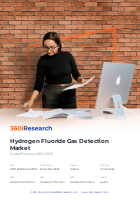
Hydrogen Fluoride Gas Detection Market by Detector Type (Fixed, Portable), Detection Technology (Catalytic Sensors, Electrochemical Sensors, Infrared Sensors), Installation, Response Time, Application, End Use Industry, Sales Channel - Global Forecast 2025-2030
SKU
MRR-3A2E844FCD0F
Region
Global
Publication Date
December 2025
Delivery
Immediate
2024
USD 614.99 million
2025
USD 647.77 million
2030
USD 846.13 million
CAGR
5.46%

Download a Free PDF
Get a sneak peek into the valuable insights and in-depth analysis featured in our comprehensive hydrogen fluoride gas detection market report. Download now to stay ahead in the industry! Need more tailored information? Ketan is here to help you find exactly what you need.



